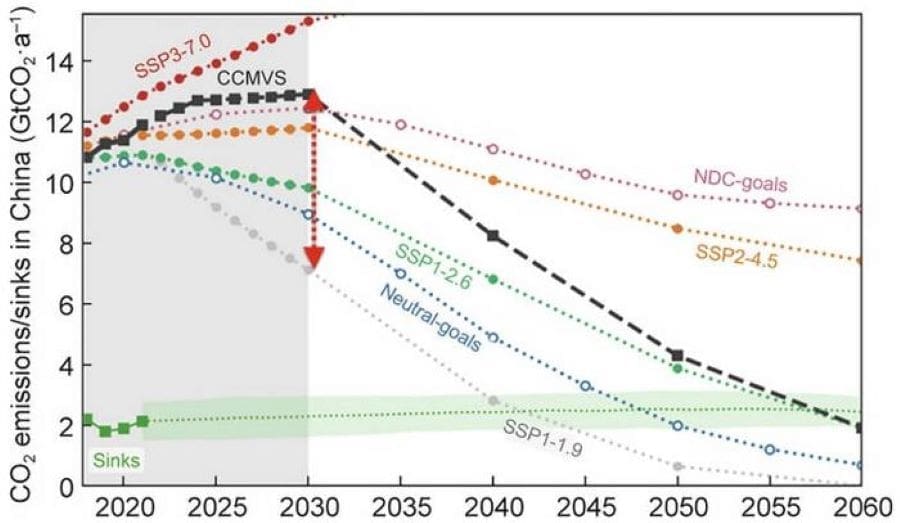Summary:
A new study published in Engineering examines how China can achieve carbon neutrality while aligning with the Paris Agreement’s 2 °C target.
The research suggests that while limiting global warming to 1.5 °C remains an aspirational goal, it may be less feasible for China due to the high economic costs — estimated at three to four times those of the 2 °C pathway. Instead, the study proposes that China should focus on reaching peak carbon emissions around 2028–2029 at approximately 12.8 billion tonnes and work toward carbon neutrality by 2060 without heavy reliance on early-stage negative-emission technologies like direct air carbon capture and storage (DACCS).
China’s approach will involve a shift toward renewable energy, restructuring its industrial framework, and leveraging carbon sinks from natural ecosystems — though the study stresses that emission reductions remain the primary driver. These efforts could help curb global temperature rise, reducing the likelihood of climate tipping points and extreme weather events.
The study also highlights key challenges, including methane reduction and climate equity, while recommending further research on realistic carbon-neutrality pathways and Earth system modeling. The findings offer valuable insights into China’s role in shaping global emissions scenarios and the future of climate mitigation.

China’s path to carbon neutrality: Aligning with the Paris Agreement’s 2°C target
The new study published in Engineering has shed light on China’s strategies for achieving carbon neutrality in line with the Paris Agreement’s 2°C target. The research, conducted by a team of Chinese scientists, explores the country’s carbon peak and carbon-neutrality pathways, and assesses their potential impacts on future climate change.
The Paris Agreement aims to limit global warming to well below 2°C above pre-industrial levels, and to pursue efforts to limit it to 1.5 °C. However, the study suggests that for China, pursuing the 1.5 °C target may be less feasible, as it could potentially incur 3~4 times the cost of pursuing the 2 °C target. Instead, China can achieve carbon neutrality by 2060 without relying on extensive negative-emission technologies like direct air carbon capture and storage (DACCS) at an early stage.
The researchers estimate that China’s anthropogenic CO2 emissions will peak between 2028 and 2029, at around 12.8 billion tonnes, and then decline continuously. By focusing on renewable energy development and transforming its energy system, China can achieve carbon neutrality around 2060, with the help of 2.1 billion tonnes of carbon sinks from terrestrial ecosystems.
Natural ecosystem carbon sinks will play a positive role in China’s carbon neutrality efforts, but the study emphasizes that emission reduction remains the key. Although these sinks can offset some emissions, their capacity is limited, and with future climate warming, their effectiveness may decline.
The study also discusses the concept of climate overshoot and the role of negative-emission technologies. While these technologies may be important in the long run, large-scale adoption at an early stage is unnecessary and economically challenging for China. Instead, China should accelerate the application of renewable energy and adjust its industrial structure.
As China reaches its carbon peak and moves towards carbon neutrality, it will have a significant impact on global climate change. The slowdown in global greenhouse gas emissions can help control the global temperature rise and reduce the likelihood of reaching climate tipping points. It may also mitigate the frequency and intensity of extreme weather events, although the complex lag effects of the climate system need to be considered.
The research further touches on issues such as loss and damage caused by climate warming, and equity in China’s carbon neutrality process, especially regarding methane reduction. China’s large population and economic scale mean that methane reduction poses a greater challenge. However, China’s commitment to carbon neutrality aligns with its development philosophy and is an opportunity for a new green development path.
The researchers suggest several areas for future research, including more realistic carbon neutrality pathways, more accurate Earth system models, and precise observational research. Despite uncertainties in China’s energy consumption structure, renewable energy development, and negative-emission technologies, this study provides valuable insights into China’s climate change mitigation strategies and their global implications.
Journal Reference:
Xiaoye Zhang, Junting Zhong, Xiliang Zhang, Da Zhang, Changhong Miao, Deying Wang, Lifeng Guo, ‘China Can Achieve Carbon Neutrality in Line with the Paris Agreement’s 2 °C Target: Navigating Global Emissions Scenarios, Warming Levels, and Extreme Event Projections’, Engineering (2024). DOI: 10.1016/j.eng.2024.11.023
Article Source:
Press Release/Material by Higher Education Press
Featured image credit: 素辉 李 (Suhui Li) | Unsplash




